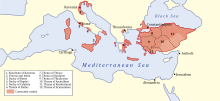Pope Sisinnius
Bishop of Rome | |
|---|---|
| Church | Catholic Church |
| Papacy began | 15 January 708 |
| Papacy ended | 4 February 708 |
| Predecessor | John VII |
| Successor | Constantine |
| Personal details | |
| Died | 4 February 708 Rome |
| Buried | Old St. Peter's Basilica, Rome |
Pope Sisinnius (died 4 February 708) was the
Background
Religious
In the late fifth century, the churches of the East and West were divided over the
The role of the pope in the time of Sisinnius, and the first millennium as a whole, was limited to that of a mediator. As the theologian
Political
The centuries preceding the reign of Sisinnius were characterized by external intervention in the selection of the pope. The eastern
Sisinnius' predecessor, John VII (r. 705–707) was installed as the bishop of Rome the same year that the Byzantine emperor Justinian II (r. 685–695, 705–711) was restored to his throne.[11] Shortly after regaining power, the latter sent several decrees of canon law from the 692 Quinisext Council to John, any of which he could approve or reject. Out of worry of displeasing the Emperor, the Pope sent the decrees back to Justinian unchanged.[12] The issue of the Quinisext canons continued into the reign of Sisinnius' successor, Constantine, who travelled to Constantinople in 711 to negotiate with the East over the matter.[13]
Life and papacy

Little information about Sisinnius before his election to the papal throne is extant.
Sisinnius was elected to become the bishop of Rome, likely in October 707, and was
Notes
References
- ^ Duffy 1997, pp. 37–38.
- ^ Duffy 1997, p. 38.
- ^ Duffy 1997, pp. 60–61.
- ^ Duffy 1997, p. 61.
- ^ McBrien 2006, pp. 4–5.
- ^ Richards 1979, p. 243.
- ^ a b Richards 1979, p. 244.
- ^ Richards 1979, pp. 246–248.
- ^ Richards 1979, p. 248.
- ^ Richards 1979, pp. 1–2.
- ^ Richards 1979, p. 211.
- ^ Richards 1979, p. 212.
- ^ Richards 1979, pp. 213–214.
- ^ a b c d e f g Kelly & Walsh 1988, p. 85.
- ^ a b Durliat 2002a, p. 1428.
- ^ a b c d e McBrien 2000, p. 117.
- ^ Richards 1979, p. 213.
- ^ a b Richards 1979, p. 250.
- ^ Reardon 2004, p. 58.
- ^ Durliat 2002b, p. 420.
Sources
- ISBN 978-0-30-007332-4.
- Durliat, Jean (2002a). "Sisinnius". In Levillain, Phillipe (ed.). The Papacy: An Encyclopedia. Vol. 3.[1]
- Durliat, Jean (2002b). "Constantine I". In Levillain, Phillipe (ed.). The Papacy: An Encyclopedia. Vol. 1.[2]
- OCLC 59172482.
- OCLC 47237751.
- Levillain, Philippe, ed. (2002d). The Papacy: An Encyclopedia. Vol. 3. New York City: Routledge. OCLC 47237751.
- OCLC 43458291.
- McBrien, Richard P. (2006). The Pocket Guide to the Popes. San Francisco: HarperCollins. ISBN 0061137731.
- Reardon, Wendy J. (2004). The Deaths of the Popes. Jefferson, North Carolina: OCLC 55845524.
- OCLC 4952990.
